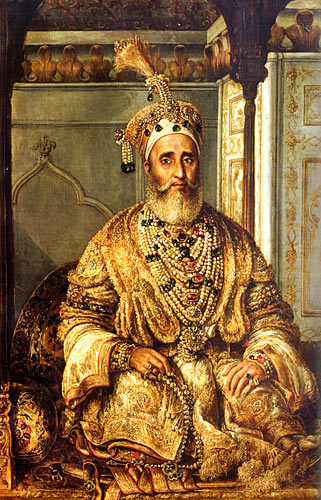 |
| Emperor Bahadur Shah II Source: Wikimedia Commons |
The din of the Great Rebellion of 1857 will continue to echo into our era, marred as it is by ongoing wars and insurgencies in Muslim lands. I believe that a careful study of those events are pertinent for American and European students of global politics today as they attempt to contextualize the challenges to American military might and Western cultural hegemony continuously pulsating onto the global stage from the remote corners of South Asia. A chronicle of 1857 is also useful to understand the fragility of a multicultural society in the face of contending religious fundamentalisms and unrelenting militarism.
In this light, William Dalrymple’s The Last Mughal (2006) provides an accessible and compelling history of the events which led to the final collapse of a tolerant and refined Indo-Islamic civilization. The book has been controversial among professional historians — particularly South Asian historians, but given the enormity of the subject matter it is digestible for an undergraduate audience and a decent entry point into an unending discussion.
The Great Rebellion, when it is not diminished and dismissed as a “mutiny,” has often been simplified as a confrontation between British imperialists and proto-nationalist Indians, but this is a drastic over simplification — if not an outright caricature of history. Dalrymple’s book helps to lay out the complex array of forces, communities, and individuals that confronted one another during the uprising — from Britons who had converted to Islam and married into notable Muslim families to Hindu soldiers who rallied to fight and die for an ageing and indecisive Muslim emperor alongside 25,000 Wahhabi-inspired jihadis/ mujahedin; and including Hindus and Muslims who had converted to Christianity and adopted British manners and sartorial accoutrement. The book intelligently and consistently resists attempts to read history through a simplifying lens or the meta-narrative of a clash of civilizations.
Nevertheless, goaded on by Christian and Islamic fundamentalists, the war did create horrific atrocities by the Britons and their Sepoy adversaries that polarized communities. In particular, Dalrymple provides an unflinching and detailed account of the crimes perpetrated by British officers and their allies after they sacked the imperial capital — belying any claims by Anglophiles that the Britons were a civilizing force and interrogating the notion of a “just retribution” for the (at times exaggerated) crimes of the rebels.
A lesson to take away from this rich and nuanced history is the role of religious fundamentalists at home and abroad in paving the pathway for slaughter — even though Dalrymple may overplay the religious element of the conflict at the expense of other important causal factors. The devaluation of foreign customs, vilification of rival religious practices, and outright attempts to insult the faith of others set in motion the rumors that would spark the rebellion and cut the last restraints on civilized behavior during and after the uprising on all sides. One often hears international relations scholars diminish the importance of words and labels in favor of material and aggregate behavioral factors. However, it is clear in Dalrymple’s account that discursive violence shaped and facilitated the return of medieval barbarity to the point that the Britons aspired to slaughter all of the inhabitants of Delhi (many of whom had remained steadfastly loyal to them even when the city was occupied by Sepoys) and to “delete” the entire city. If nothing else, the book alerts the reader to understand the very real consequences that accompany a rhetoric which denigrates the culture, faith, and traditional forms of political legitimacy in other communities. This is a simple lesson, but one that is often lost on policy makers, scholars and students committed to a modernist discourse.
Vikash is an Associate Professor of Political Science and Asian Studies at Hobart and William Smith Colleges in Geneva, NY. His main areas of academic interest are (post-) globalization, economic development, and economic freedom, with a regional focus on South Asia


0 Comments